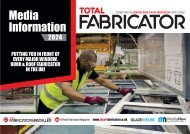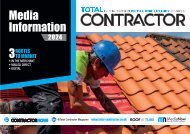January 2019
You also want an ePaper? Increase the reach of your titles
YUMPU automatically turns print PDFs into web optimized ePapers that Google loves.
“Skipping these<br />
important control<br />
checks is equally likely<br />
when there is a<br />
collective focus to<br />
achieve maximum<br />
productivity in<br />
anticipation of a<br />
looming valuation<br />
date”<br />
Above: A primed roof and air and vapour control layer installation.<br />
Whilst it may seem that the most organised<br />
approach is to schedule all materials and labour<br />
resources before the bond tests have been<br />
completed, there is a risk that works may proceed<br />
without the proper checks being undertaken. We<br />
have seen this happen when labour resources<br />
have targets to meet, or presume that pre-checks<br />
have already been completed by others. However,<br />
skipping these important control checks is equally<br />
likely when there is a collective focus to achieve<br />
maximum productivity in anticipation of a looming<br />
valuation date.<br />
If for any reason a problem with the attachment<br />
to a structural deck is discovered during the<br />
installation, inevitably there is a strong pressure<br />
to attempt to continue with the same materials<br />
and / or primers already on site, which may not<br />
be suitable. It could be reasonably argued that<br />
whilst changing materials at this stage may<br />
introduce delays, those delays are likely to be a<br />
lot shorter (and less costly), than having to<br />
resolve the problem post-handover.<br />
So what are the risk conditions? Is it only in the<br />
winter time that bond tests are required before<br />
commencing? No. This should be standard<br />
practise so that everyone involved can be<br />
assured that the appropriate application method<br />
has been determined. For those using structural<br />
hot melt products, this practise of bond tests<br />
before commencement of the work appears<br />
engrained in our culture. It is commonplace to<br />
arrive at most sites and see test patches of<br />
structural hot melt systems accompanied with<br />
detailed records of the tests completed. But, why<br />
is this practise not as engrained with other<br />
technologies? It should be standard practise<br />
across the board.<br />
By progressing your installation without these<br />
bond tests it is often viewed by main contractors<br />
that you are accepting the condition of the deck.<br />
And they may have a point.<br />
Beyond simply waiting for the deck to fully cure<br />
(which is another topic in itself), here are few<br />
other conditions to consider:<br />
Sub 5°C Conditions: During these lowtemperature<br />
conditions, there is a risk that surface<br />
condensation may exist on the structural deck. This<br />
is one of the reasons why many products advise<br />
that they should only be applied in greater than 5°C<br />
conditions, despite the products themselves<br />
functioning in sub-5°C temperatures.<br />
Screeds: Sand-cement screeds are often used for<br />
levelling purposes or providing a suitable roof fall.<br />
The problem is that these products are like<br />
sponges and absorb water every time it rains.<br />
Interestingly, whilst it may seem more expensive<br />
on paper to consider tapered insulation, there may<br />
be a saving on the overall project package if you’re<br />
able to get your waterproofing completed quicker,<br />
allowing internal works to proceed and scaffolding<br />
and other attendances to be struck earlier.<br />
Zero Falls (less than 1:80): A minimum fall on<br />
your roof will ensure that it drains and BS 6229<br />
advises that to achieve a minimum 1:80 finished<br />
“It is important to<br />
ensure that the deck is<br />
fully dried so that you<br />
are bonding to the<br />
concrete deck itself,<br />
not a layer of water”<br />
fall, you should design at either 1:60 or 1:40 to<br />
allow for tolerances during the construction<br />
(depending on how much information is available).<br />
However, how often do we see zero-falls designs<br />
which are designed at zero falls, rather than say<br />
1:80 to achieve a close to zero fall (after<br />
tolerances)? In these conditions both the drying<br />
time of the structural deck, and keeping the deck<br />
dry after rainfall, are likely to be troublesome.<br />
However, in the condition of a zero-fall design it is<br />
likely that this problem may be further<br />
exaggerated, due to the formation of back-falls.<br />
In all of these conditions, it is important to ensure<br />
that the deck is fully dried so that you are bonding<br />
to the concrete deck itself, not a layer of water,<br />
which is not known for its adhesive properties.<br />
If utilising a traditional gas-torch to dry your roof<br />
deck, check the NFRC Safe2Torch guidance<br />
document: www.nfrc.co.uk/Safe2Torch.<br />
Contact Danosa<br />
0845 074 0553<br />
www.danosa.co.uk<br />
@DANOSAUK<br />
JANUARY <strong>2019</strong> TC 41

















